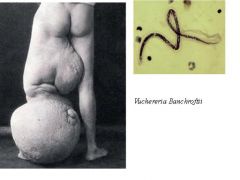![]()
![]()
![]()
Use LEFT and RIGHT arrow keys to navigate between flashcards;
Use UP and DOWN arrow keys to flip the card;
H to show hint;
A reads text to speech;
5 Cards in this Set
- Front
- Back
|
Wuchereria bancrofti - disease? Type of parasitic agent?
|
Disease: Elephantiasis
Filarial worm: Wuchereria bancrofti |
|
|
Wuchereria bancrofti - Causative Agents
|
Causative Agents:
Filariasis is caused by nematodes (roundworms) that inhabit the lymphatics and subcutaneous tissues. Eight main species infect humans. Three of these are responsible for |
|
|
Wuchereria bancrofti - Geographic Distribution
|
Geographic Distribution:
Among the agents of lymphatic filariasis, Wuchereria bancrofti is encountered in tropical areas worldwidemost of the morbidity due to filariasis: Wuchereria bancrofti |
|

|
Wuchereria bancrofti
|
|

Wuchereria bancrofti - morphology
|
An Adult female Wuchereria bancrofti is about 80–100 mm long and 0.24–0.30 mm in diameter, whereas a male is about 40 mm long and 0.1 mm in diameter. is about 240–300 µm (micrometers) long and 7.5–10 µm thick. It is sheathed and has nocturnal periodicity, except the South Pacific microfilaria which does not have marked periodicity. It has a gently curved body, and a tail that is tapered to a point. The nuclear column (the cells that constitute its body) is loosely packed. The cells can be seen individually under a microscope and do not extend to the tip of the tail. Microfilariae circulate in the blood.
|

